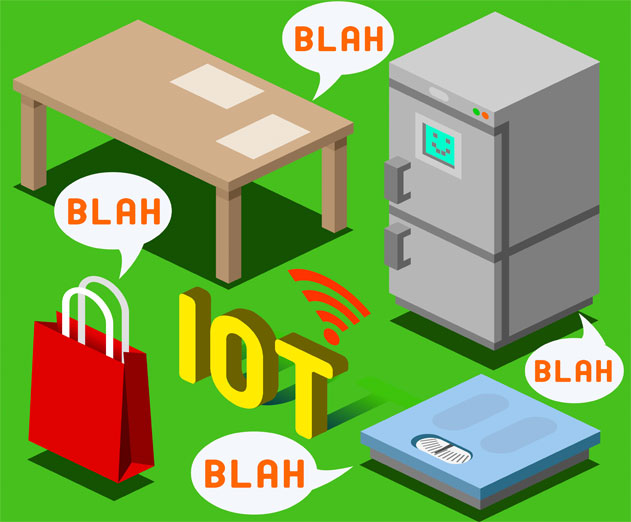The Challenges of IoT Interconnectivity and How to Tackle Them
Thursday, February 4, 2016

|
Rashad Barghouti |
The interconnectivity of IoT devices is key to the development of a connected world. If these devices could communicate, possibilities for developers would be endless; however, IoT lacks seamless interoperability, which allows devices to “talk,” or connect, with each other.
Many IoT devices, specifically small devices, are not compatible due to varying controls. With Gartner’s prediction that 6.4 billion connected things will be in use worldwide by 2016, up 30 percent from last year, and 21 billion things by 2020, the challenge of integrating these devices only increases. At the same time, the need to create a communication framework, unify tools and software, standardize networking technology and make room for IPv6 also rises in importance.
Creating a Communications Framework - It’s a piece of cake, right?
The primary focus of interoperability is a communication framework - a framework that isolates the user from having to worry about compatibility. The trouble here is the whole process of device communication. How do you create standardization across all devices?
The best way to think of this communication is to picture IoT communication as a cake with many layers. Wi-Fi at the bottom, the core operating system as the next layer, middleware following and framework that isolates the user at the very top, like the icing.
All of the layers represent network technologies that need to work together in order to create consistency across the entire cake. Each layer is uniquely important, but you need all ingredients to work together for a complete cake. The proper framework of IoT is absolutely key for communication to occur between small devices.
Unifying Tools and Software
Tools and software also require homogeneity. There needs to be a uniform code appealing to each unique user and demand. Writing this code can become very complex, which is why there needs to be one language spoken across all devices to simplify platforms.
For example, a uniform code would create a bridge between platforms like Microsoft Office and iTunes. However, it is difficult to develop from one platform structure to another because unfortunately, coding knowledge doesn’t transfer easily. To help create this continuity, an abstraction layer needs to come into play.
An abstraction layer allows for a common theme among different devices so they are able to connect. The proper tools and software need an abstraction layer to mask differences in devices, which allows for one uniform code to work across all varieties.
Standardizing networking technology
Due to the significant increase of small IoT devices, the problem is that all of these new devices are speaking different languages when trying to connect with the home network. Currently, the majority of home devices are powered by Wi-Fi or a lower power version of Bluetooth (BLE).
The devices, made by many different manufacturers, connect to the network through either gateway, but are having trouble speaking to each other. For this reason, there needs to be one agreed upon standard across all networking technology. Simplifying the options will allow for the discovery of more devices in range, which begins with the standardization of Wi-Fi and Bluetooth.
Standardization plays a big role when it comes to wireless communication and controlling systems. We need to discover what operating system will dominate in the future.
Making room for growth: IPv6
Every Internet-connected device requires its own unique IP address in order to connect to the global network. As more devices are developed, we need more signatures and available IP addresses. How many more? According to Google, we need about 340 trillion trillion trillion. Every device on the market currently runs on IPv4, which only has room for a specific number of allocated addresses and is close to running out.
There is good news though. A solution is on the rise built to handle the increasing number of devices. IPv6 is a new version of the Internet Protocol designed to overcome the limitations of IPv4 and will allow endless signatures. According to Gartner, the main benefits of this new IP is the vastly increased address space, integrated security and quality-of-service mechanism, auto configuration, and mobility.
The new IP address will allow each device to be unique with its own identifier. The Thread Group, backed by Google, is an IP-based wireless networking protocol natively carrying IPv6. It uses IPv6 to unify IoT and push for a more common standard across all devices. IPv6 is crucial, from a networking structure, in order to handle numerous new devices connecting to the Internet. Thanks to IPv6, the Internet will not be running out of room anytime soon.
Needless to say, the future of IoT is bright and exciting. Billions of new devices have the potential to shape the way we work and live, while promoting breakthroughs in productivity, healthcare and finance. Through the integration of IoT, consumers’ homes and lives will also be greatly impacted, for the better.
IoT innovation can prevent disasters in homes. For example, a dripping water heater has the potential to flood a home, but could be prevented by connected devices. To turn these possibilities into reality, it is imperative that the developer community works to address the challenges of IoT interconnectivity to make way for a better, connected future.
Read more: https://software.intel.com/en-us/iot/home
This content is made possible by a guest author, or sponsor; it is not written by and does not necessarily reflect the views of App Developer Magazine's editorial staff.

Become a subscriber of App Developer Magazine for just $5.99 a month and take advantage of all these perks.
MEMBERS GET ACCESS TO
- - Exclusive content from leaders in the industry
- - Q&A articles from industry leaders
- - Tips and tricks from the most successful developers weekly
- - Monthly issues, including all 90+ back-issues since 2012
- - Event discounts and early-bird signups
- - Gain insight from top achievers in the app store
- - Learn what tools to use, what SDK's to use, and more
Subscribe here

_r2f0ox12.jpg&width=800)










